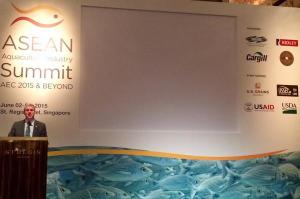Growth of aquaculture operations meant to help meet customer demand from the one billion people who rely on fish as their primary protein source is also encouraging diversification of feed ingredients, including distiller’s dried grains with solubles (DDGS) and soy.
Pressure on wild fish stocks is a constant concern, making aquaculture one of the world’s fastest growing industries. Asia accounts for nearly 90 percent of global aquaculture production.
This is a strategic opportunity for U.S. producers, and last week the U.S. Grains Council (USGC) joined with several longtime partners, including the U.S. Soybean Export Council (USSEC), the U.S. Department of Agriculture’s (USDA’s) Foreign Agricultural Service (FAS) and U.S. Agency for International Development (USAID), in a landmark conference in Singapore to explore long-term options for the industry.
“The role of USGC in aquaculture is clear,� said Kevin Roepke, USGC regional director of South and Southeast Asia. “The aquaculture industry needs to move on from using large amounts of rendered wild fish for feeds and transition to using a suite of plant-based proteins and ingredient sources.�
While fish meal remains the primary protein source today, the picture is beginning to change. In production models like the one emerging in Vietnam, imported feed ingredients from the United States are fed to seafood and, in turn, the finished fish is re-exported back to the United States.
“It’s a case study in comparative advantage,� Roepke said. “Yet the challenge facing the industry is finding a production system that is environmentally friendly, consumer-oriented and economically viable.�
The growth potential is dramatic, and the challenges are stark. A recent study conducted by the United Nations’ Food and Agriculture Organization (FAO) and Worldfish concluded that the Association of Southeast Asian Nations (ASEAN) aquaculture production must grow by as much as 100 percent by 2030 in order to satisfy demand.
But as the industry expands, growing pains are appearing. Sustainability is an issue for producers and consumers alike, and one of the aquaculture industry’s traditional commodity protein sources, trash fish, has a poor environmental track record.
Concerns about overfishing are especially acute; according to FAO trash fish are often immature fish that would be commercially fished if allowed to grow to a larger size.
Sustainability, however, is complex to define and sometimes poses difficult issues. There is confusing overlap among different certification agencies, and choosing the right one can be problematic. Lack of harmonization in regulation and certification creates confusion on the retail side and perplexes consumers. Compounding the problem is an absence of harmonization as there are a number of different national standards and even company-specific standards that pose serious challenges in an integrated global market.
Last week’s conference provided a platform for individual companies, countries and stakeholders to present the ASEAN secretariat with a roadmap towards regulatory and certification harmonization. The conference attracted more than 100 participants representing the Southeast Asian aquaculture industry, government and other stakeholders. Following the completion of the conference, a dossier with seven action items was presented to the ASEAN secretariat for follow up.
“Aquaculture, above anything else, defines the mantra: ‘When trade works, the world wins,� Roepke said. “Fish is the world’s most valuable exported food commodity with a total worth greater than that of corn, soybeans and beef combined. Its role in achieving global food security cannot be overlooked. Conferences like this exhibit the work that is being done by both USGC and USSEC to contribute to a more sustainable aquaculture industry.�


